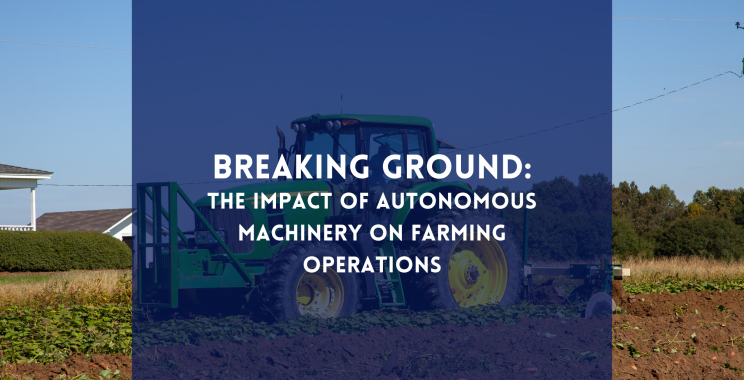Breaking Ground: The Impact of Autonomous Machinery on Farming Operations
In the vast expanse of agricultural landscapes, a technological revolution is underway. Autonomous machinery, once the realm of science fiction, is now breaking ground in farming operations around the world. From self-driving tractors to unmanned aerial vehicles, these innovative machines are reshaping the way we farm, bringing unprecedented efficiency, precision, and sustainability to the field. In this blog post, we’ll explore the transformative impact of autonomous machinery on farming operations and its implications for the future of agriculture.
The Rise of Autonomous Farming
Autonomous farming, also known as robotic farming or driverless agriculture, refers to the use of unmanned machinery to perform various tasks traditionally carried out by human operators. These machines are equipped with advanced sensors, GPS technology, and artificial intelligence algorithms, allowing them to navigate fields, make decisions, and execute tasks with minimal human intervention.
Enhanced Efficiency and Productivity
One of the most significant benefits of autonomous machinery is its ability to enhance efficiency and productivity on the farm. Unlike human operators, autonomous machines can work around the clock, without the need for breaks or rest. This continuous operation enables farmers to maximize their field time, making the most of favorable weather conditions and tight planting and harvesting windows.
Moreover, autonomous machinery operates with unparalleled precision, ensuring consistent and uniform performance across the field. From planting and fertilizing to spraying and harvesting, these machines can execute tasks with exactitude, resulting in higher yields, reduced input costs, and improved crop quality. By leveraging advanced sensors and GPS guidance systems, autonomous machinery can navigate fields with precision, minimizing overlap and waste while optimizing resource use.
Reduced Labor Dependency
Labor shortage is a significant challenge facing the agriculture industry, particularly in regions where the workforce is aging or migrating to urban areas. Autonomous machinery offers a solution to this problem by reducing dependency on human labor. With autonomous tractors, drones, and robots handling routine tasks such as planting, spraying, and monitoring, farmers can alleviate the burden on their workforce and focus on more strategic aspects of farm management.
Additionally, autonomous machinery can address labor challenges associated with seasonal fluctuations and peak workload periods. During busy seasons like planting and harvest, autonomous machines can operate autonomously, supplementing human labor and ensuring that critical tasks are completed on time and efficiently.
Environmental Sustainability
Autonomous farm machinery is also driving environmental sustainability in agriculture by reducing resource use and minimizing environmental impact. By operating with precision and efficiency, autonomous machines can optimize inputs such as water, fertilizers, and pesticides, minimizing waste and runoff. This targeted application not only conserves resources but also reduces chemical pollution and soil degradation, promoting long-term sustainability.
Furthermore, autonomous machinery can facilitate the adoption of conservation tillage practices, such as no-till and reduced tillage. By minimizing soil disturbance and erosion, these practices help preserve soil health and organic matter, enhance water retention, and mitigate climate change impacts. Autonomous machines equipped with soil sensors and mapping capabilities can assess soil health in real time, enabling farmers to make informed decisions that promote environmental stewardship.
Future Prospects and Challenges
While the potential benefits of autonomous machinery in farming operations are vast, there are also challenges and considerations to address. Technical complexities, such as sensor accuracy, data integration, and cybersecurity, must be overcome to ensure the reliability and safety of autonomous systems. Additionally, there are regulatory and ethical considerations surrounding the use of autonomous machinery, particularly in areas such as liability, privacy, and ethical treatment of animals.
Despite these challenges, the future of autonomous machinery in agriculture looks promising. As technology continues to advance and adoption rates increase, we can expect to see further innovations in autonomous farming, from swarm robotics and collaborative systems to AI-driven decision support tools and predictive analytics. These advancements will continue to revolutionize farming operations, driving efficiency, sustainability, and resilience in the face of evolving challenges.
Conclusion: Pioneering the Future of Agriculture
In conclusion, autonomous farm machinery is revolutionizing farming operations and paving the way for a more efficient, sustainable, and resilient agriculture industry. From enhanced productivity and reduced labour dependency to environmental sustainability and future prospects, the impact of autonomous machinery on farming operations is profound and far-reaching. As we continue to break ground in autonomous farming, we are pioneering the future of agriculture, one field at a time.
Tags: farm machinery, farming, farm tips

